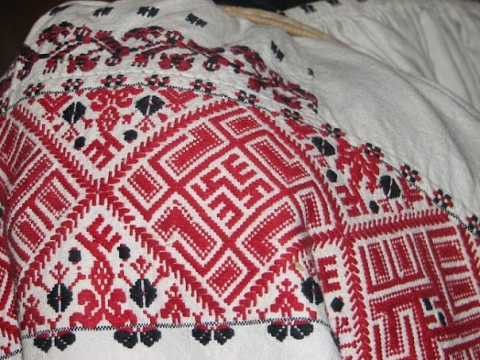 In ancient times, people tried to decorate their products with primitive drawings, composing amazing ornaments from them. Trying to understand the world around them, the meaning of natural phenomena, people depicted the forces and images of nature with symbolic signs, believing that in this way they would be able to appease the harsh elements and attract good natural gifts and phenomena, and receive protection from illness and death.
In ancient times, people tried to decorate their products with primitive drawings, composing amazing ornaments from them. Trying to understand the world around them, the meaning of natural phenomena, people depicted the forces and images of nature with symbolic signs, believing that in this way they would be able to appease the harsh elements and attract good natural gifts and phenomena, and receive protection from illness and death.
Our ancient ancestors did not possess the subtleties of painting, they created their images using signs that had a certain meaning. For example, a horizontal straight line depicted the earth, a wavy one - water, a vertically inclined one - rain, a cross meant fire or the sun. From these and other signs they created an ornament that carried certain, specific information.
Not understanding the essence of natural phenomena, ancient people considered them living beings that had feelings and consciously performed actions, which is why they depicted them in the form of animals, birds, and mysterious mystical images.
Figurative signs were accumulated and improved over the centuries. One of the main ornaments of farmers was the sign of the Sun. This sign was present in the decorations of all household and work objects of the Slavs.
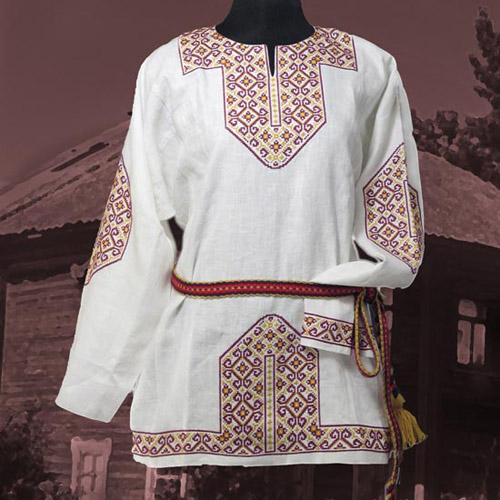 Ornaments were used in various types of folk art: pottery, woodcarving, weaving, and, of course, embroidery. And everywhere the central place was occupied by the symbol of the Sun, depicted in the form of rosettes, and sometimes diamonds or horses.
Ornaments were used in various types of folk art: pottery, woodcarving, weaving, and, of course, embroidery. And everywhere the central place was occupied by the symbol of the Sun, depicted in the form of rosettes, and sometimes diamonds or horses.
For the farmer, the main breadwinner was the earth. Their life depended on its fertility. The fertile earth was compared to a mother, a woman who continues the family. There are different names for this image - Bereginya, Makosh, Mokosha, Rozhanitsa, Mother Earth and others.
The figure of a woman was depicted very conventionally. Sometimes she resembled a tree with raised branches. Even the head was symbolically marked in the form of a rhombus - an ancient solar symbol.
This female image is reminiscent of Scythian clay figures. The hands of the stone women, just like the maternal symbol of fertility, are raised up. The stone women were created in clothes with ornaments along the hem, on which the signs of the sun and sprouted grains are visible. The female figure with her hands directed towards the sky symbolically united the earth with the sky.
Ancient embroidery methods
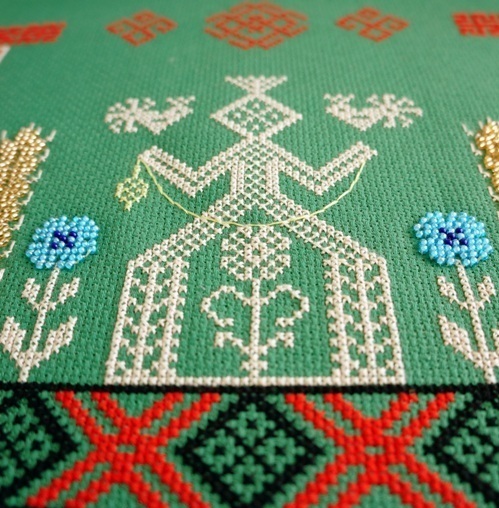 Embroidery is a type of folk art that has preserved the largest number of ancient patterns, developed them qualitatively and uses them taking into account their symbolic meaning. Slavic peoples apply embroidered ornaments to many items of clothing, decorating their everyday life with them.
Embroidery is a type of folk art that has preserved the largest number of ancient patterns, developed them qualitatively and uses them taking into account their symbolic meaning. Slavic peoples apply embroidered ornaments to many items of clothing, decorating their everyday life with them.
Ancient people paid great attention to protecting the human body from external evil influences. The fabric was protected from evil forces during its manufacture, so they did not pass through it, but the edges of clothing, open to prying eyes, had to be protected with amulet symbols. Ornaments were embroidered on the chest cut of the shirt, the collar, on the edges of the sleeves or cuffs, on the hem, which was visible from under the outerwear.
The main color of traditional embroidery is red. It has an important symbolic meaning. Different dyes were used, so there were a large number of shades.
Ancient embroideries were mostly done with counted stitches, in which the threads of the fabric were carefully counted to obtain even stitches. The embroiderer begins work by marking the location and size of the ornaments with large stitches. There are several types of counted stitches, among which the most popular are the stitches "set", "painting" and "counted smooth".
Embroidery thread material
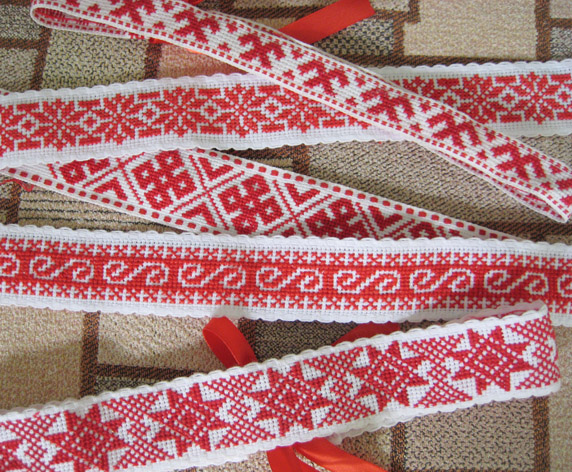 Cotton threads are good protection against the evil eye and curses that can come from unkind people.
Cotton threads are good protection against the evil eye and curses that can come from unkind people.
Silk threads help increase clarity of thinking and support when career problems arise.
Wool restores disturbed energy, so it is great for those people who have been attacked by energy vampires, have physical or nervous illnesses. Patterns with woolen threads are placed on the collar, on the chest - opposite the heart and solar plexus, along the hem of the shirt in the lower abdomen. The main chakras are located in these parts of the body. Patterns with images of animals, trees and fruits are embroidered with woolen threads. This material is not suitable for embroidering stars and birds. Warm wool is suitable for embroidering the sun - a source of heat and light.
Patterns made of linen threads are calming. The most suitable for linen are images of ancient symbols of the sun, birds, trees and stars.
When creating an embroidery ornament for a single product, you should avoid combining amulet patterns of different purposes. For example, calming signs do not combine with signs of activity and strong energy. Both signs are good, but they should be embroidered on different products. The thread material should also be selected to be uniform for the entire embroidery ornament.
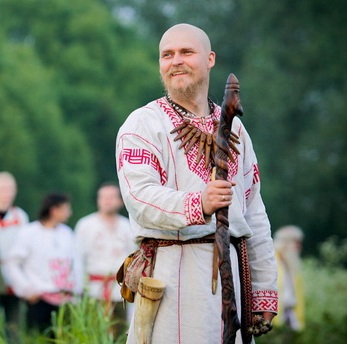 If you are embroidering a charm, do not make knots of thread on either the front or back of the embroidery, as knots disrupt the smooth flow of protective energy.
If you are embroidering a charm, do not make knots of thread on either the front or back of the embroidery, as knots disrupt the smooth flow of protective energy.
The location of embroidery on clothes and the color scheme of ornaments
There are two types of placement of embroidered ornaments on clothes: traditional - collars, sleeves, hems, belts, and non-traditional - those places that you yourself want to protect and direct positive energy to.
The color of the ornament emphasizes and enhances the influence of magical signs on a person.
Ornaments of red color of various shades, containing signs in the form of crosses and circles, are a talisman in love.
Red or black patterns depicting a rooster or a horse protect young children. Ornaments made of blue and purple threads will help a schoolchild not to get tired of studying.
Blue embroidery or golden-green promotes success in any profession.
Making amulets
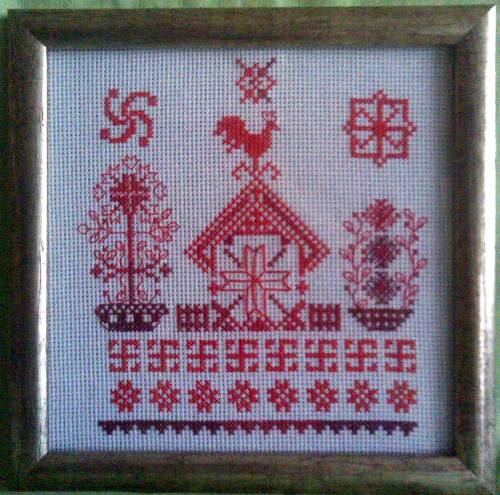 Over time, the art of making amulets has developed certain traditions that must be followed in order for the amulet to be effective.
Over time, the art of making amulets has developed certain traditions that must be followed in order for the amulet to be effective.
The first rule is the most basic. You should not create a talisman for yourself.
The second rule. A talisman is created for a loved one with great desire, with sincere love. Under coercion, as a result of giving in to persistent persuasion, it is impossible to create a good talisman.
Rule Three. The most powerful amulets are those made by you for your blood relatives, especially close ones, such as children, sisters and brothers, and parents.
The relationship between spouses is not blood, but if the spouses are united by a kinship of souls and have created a happy, friendly family, then their amulets for each other will have great power.
From the day of the wedding, the married couple already has mutual amulets - these are wedding rings. According to ancient tradition, they should be silver. In shape, wedding rings should be simply smooth, without inserts, precious stones and patterns, because this reduces their magical power. You can not remove wedding rings for a long time, so as not to break the mutual spiritual connection. Wedding rings are considered a pair of magical amulets.
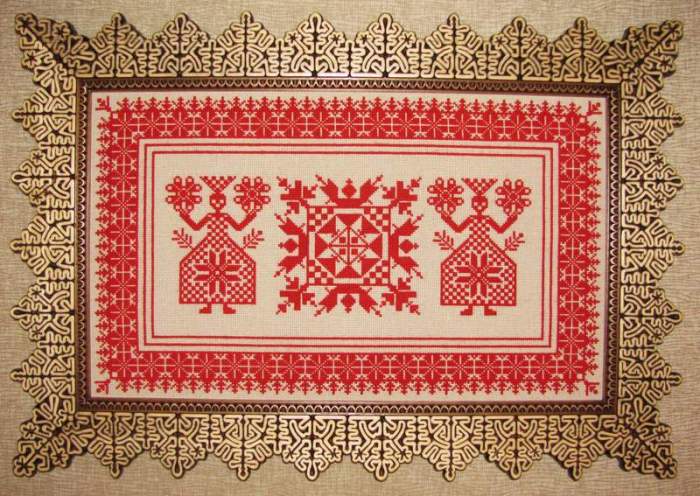 Rule Four: Before making an amulet, study the magical properties of the materials. The materials from which you will make an amulet should be well suited to the person for whom you are making the amulet.
Rule Four: Before making an amulet, study the magical properties of the materials. The materials from which you will make an amulet should be well suited to the person for whom you are making the amulet.
Rule Five. When making a talisman for a relative you like, you should always think good things about him, feel his energy, and understand his character and desires.
By following these simple rules, you will create wonderful amulets for your loved ones that will attract the desired benefits and protect them from troubles.
Since ancient times, the most common amulet among the Slavs was embroidery. To create it, materials available to ordinary people were needed - linen, woolen and cotton threads. Taking into account the meaning of ornaments and colors, embroiderers created strong amulet embroideries on the clothes of loved ones, towels and other fabric products for the home.
Amulet embroidery on children's clothes
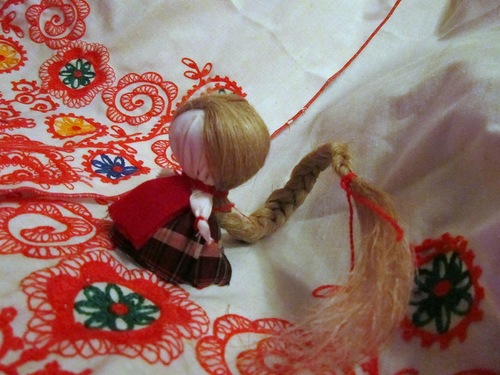 In the villages, it was customary to sew clothes for babies from worn-out parental items. The fabrics from these clothes had been washed many times, so they became quite soft for the baby's skin. But the main thing is that the parental items absorbed their energy, which could protect the child from curses and diseases. Clothes for children were sewn depending on gender - girls from their mother's items, boys from their father's. So girls at the beginning of life received the energy of motherhood, and boys received strong male energy.
In the villages, it was customary to sew clothes for babies from worn-out parental items. The fabrics from these clothes had been washed many times, so they became quite soft for the baby's skin. But the main thing is that the parental items absorbed their energy, which could protect the child from curses and diseases. Clothes for children were sewn depending on gender - girls from their mother's items, boys from their father's. So girls at the beginning of life received the energy of motherhood, and boys received strong male energy.
As children grew up, they acquired their own little defenses. At the age of three, they were sewn their first shirt from new fabric. Twelve-year-old girls were already wearing girls' shirts, and boys were wearing their first adult trousers.
The clothes of children under three years of age were not just made of soft fabric, they also had embroidery, which was preserved from the clothes of their parents. This embroidery influenced the children, passing on to them heredity, the connection of generations. Amulet embroidery accumulated many years of experience of the older generation and passed it on to the younger. Feeling the energy of his father-hunter, the boy, as he grew older, showed interest in hunting, the embroiderer's daughter was interested in embroidery. In any case, children felt the protective power of their parents through embroidery.
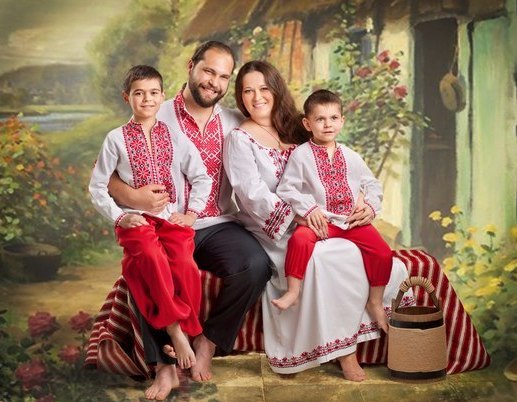 When it was time to sew a child's own shirt, the mother created an individual amulet embroidery for her, for which she used red threads. Embroidery for adults could be multi-colored. Women's red embroideries were complemented by black - the color of the earth, which protects against infertility. Men's amulet embroideries included blue and green, which protect against natural elements and from injuries. As long as external dangers did not affect children, they were protected by their kind, one red color was enough for them - the color of family ties.
When it was time to sew a child's own shirt, the mother created an individual amulet embroidery for her, for which she used red threads. Embroidery for adults could be multi-colored. Women's red embroideries were complemented by black - the color of the earth, which protects against infertility. Men's amulet embroideries included blue and green, which protect against natural elements and from injuries. As long as external dangers did not affect children, they were protected by their kind, one red color was enough for them - the color of family ties.
Girls' shirts were decorated with embroidery on the sleeves, around the neck and along the bottom of the hem. Married women embroidered shirts on the chest, collar, and sleeves. The hem was decorated with wider embroidery than girls' shirts, because the ornaments were complemented by symbols of the man's lineage.
The girl's ornaments included: symbols of her lineage, the land, the Goddess of Fate, the symbol of the girl's birthday, and symbols of women's needlework.
Boys were embroidered with symbols of fire and the sun, totem animals, a symbol of their clan and birthday, bells, and symbols of crafts for men.
Up to the age of twelve, some amulets for boys and girls could be the same, just children's. After the age of twelve, teenagers wore more specific youthful or girlish amulets, which became fewer in number, because teenagers were no longer as defenseless as toddlers. A belt was added to their clothes.
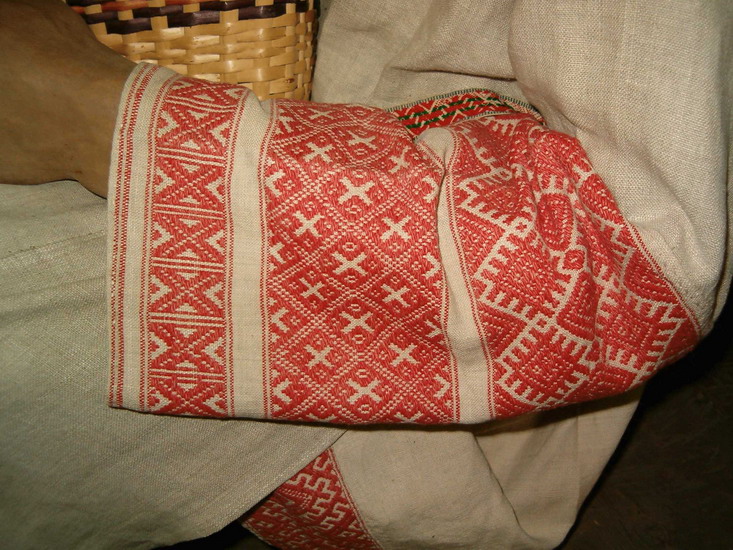 Embroidered ornaments for teenagers depicted Gods as patrons. Girls' embroideries contained symbols of fertility, while boys' embroideries contained symbols of warriors. Such symbols were not embroidered on babies.
Embroidered ornaments for teenagers depicted Gods as patrons. Girls' embroideries contained symbols of fertility, while boys' embroideries contained symbols of warriors. Such symbols were not embroidered on babies.
Embroidered amulet ornaments protected children, guarded them from evil and misfortune, and united all people with Nature.
Even very ancient people created their own ornaments. They decorated with them the objects that surrounded them and helped them live in harsh natural conditions. People decorated clay vessels and tools of their labor with patterns. The patterns consisted of straight and wavy lines, dots, rhombuses, and so on. Scientists are still trying to understand the meaning of these signs and express their hypotheses.
In their opinion, ancient man, being a hunter, understood that the tusk of a wild beast was his strength and weapon. The rhombus represented a cut of the tusk or the tusk itself, it meant power and enormous strength. To strengthen their strength, people depicted a rhombus on surrounding objects and even on their bodies.
Several overlapping diamonds mean successful hunting, life, and fertility. The repetition of patterns depicts a person's invocation to natural forces and gods with a request for success in hunting and other life matters.
In addition to rhombuses, there were other signs. Horizontal straight lines denoted land, wavy lines denoted water, and straight oblique lines depicted rain, which blocked the movement towards the sun.
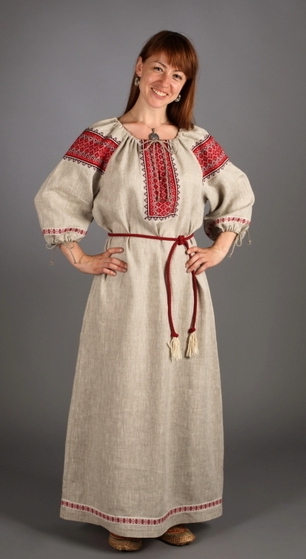 Ancient people created many signs denoting the sun, the so-called solar signs. They are quite diverse. Among other symbols, the sun is depicted in various types of crosses. Some of them are located inside a circle, and the whole sign resembles a wheel. Perhaps ancient people, watching the sun roll across the sky during the day, imagined it as a fiery wheel. Instead of a circle, the curved ends of a cross were often depicted, symbolizing the constant movement of the sun. This sign was called Yarga or a spinning wheel. It symbolized well-being.
Ancient people created many signs denoting the sun, the so-called solar signs. They are quite diverse. Among other symbols, the sun is depicted in various types of crosses. Some of them are located inside a circle, and the whole sign resembles a wheel. Perhaps ancient people, watching the sun roll across the sky during the day, imagined it as a fiery wheel. Instead of a circle, the curved ends of a cross were often depicted, symbolizing the constant movement of the sun. This sign was called Yarga or a spinning wheel. It symbolized well-being.
By deciphering the symbols of our ancestors, we begin to understand their attitude to the world around them, to nature. Ancient people created their ornaments as spells to the forces of nature, asking for their protection and intercession. Subsequent generations preserved and multiplied the symbols that meant goodness, luck, prosperity, and bountiful harvests.
The purpose of amulets corresponds to the name - to protect us from various troubles in difficult times. Whatever negative influence evil forces may direct at a person, the amulet will protect its owner with the power of the ancient symbols of our ancestors. The protection of the amulet is effective in diseases, both natural and those that appeared as a result of a curse or evil eye. The amulet will stand as an obstacle in the way of hostile pressure on the psyche, soul and emotions of a person, will protect against suggestions, love spells, depression.
Over the centuries, our ancestors have accumulated knowledge about the magical power of objects and symbols, their ability to protect people from all evil. Various things are endowed with magical power - necklaces, bracelets, pendants, household items, decorations above the entrance to the house, on the gate, on the windows, embroidered magical patterns on clothes depicting symbols of human patrons and natural gods.
Now most of the protection skills that the ancient Slavs constantly used have been forgotten. We have become more open and defenseless before the shadow world, its evil forces. They freely enter our body, consciousness, and life, destroying and oppressing us. We are tormented by incomprehensible ailments, and we do not understand what these diseases are and where they came from.
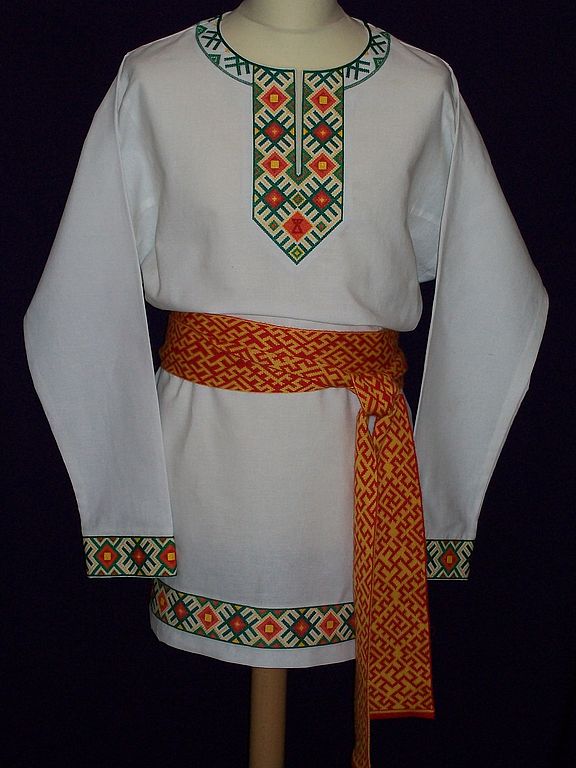 The amulet affects certain colors of the aura, restoring damaged areas and preventing them from being affected by destructive forces. By wearing clothes with embroidery of the desired color and pattern, you protect yourself from harmful influences, the imposition of other people's thoughts on you, and strengthen the integrity and harmony of your aura, which is a necessary condition for health.
The amulet affects certain colors of the aura, restoring damaged areas and preventing them from being affected by destructive forces. By wearing clothes with embroidery of the desired color and pattern, you protect yourself from harmful influences, the imposition of other people's thoughts on you, and strengthen the integrity and harmony of your aura, which is a necessary condition for health.
Questions arise: what are amulets, what do they look like, what are they made of? The strongest are amulets that have accumulated their beneficial power over many generations of the family, which are passed down by inheritance. Most family amulets are passed down through the female line - jewelry, decorative household items, clothing. Male household items made specifically for the man of your family are passed down through the male line. However, unfortunately, not every family has such amulets, so you need to make an amulet for your relatives yourself, which will then be passed down to the next generations. Only a professional can make a jewelry item, and for us, the most affordable is to make an amulet from an embroidered ornament. This is a very effective amulet. Especially careful embroidery is good for babies, because you cannot put jewelry in the form of pendants or rings on them. Such embroidery should consist of images of good magical ancient Slavic creatures: a dog, a horse, a rooster, fairy-tale birds. Various natural forces also have their own designations, which have developed since ancient Slavic times.
Ancient Slavic amulets
- Wavy lines are signs of Water. Rivers and underground currents were depicted as horizontal waves, rain as vertical ones.
- The thunderbolt (a circle or hexagon with a hexagonal cross inside) is a sign of Thunder and the god Perun, who was called the thunderbolt. This sign was a talisman for the military, and also protected against thunderstorms.
- A rhombus or square divided into four equal parts meant a plowed field, with dots inside the squares meaning a sown field. It was a sign of the earth, a sign of fertility.
- Colocross (cross inside a circle) - a sign of the Sun. Blocks the path of evil, a sign of protection and closure.
- Krada (lattice) is a sign of Fire. This sign symbolizes a funeral or sacrificial fire.
- Cross - a sign of Fire. It was depicted as a straight or oblique equilateral cross.
- Moon - the sign of the Moon, the Moon.
- The rooster's comb, which has seven protrusions, is a sign of Fire.
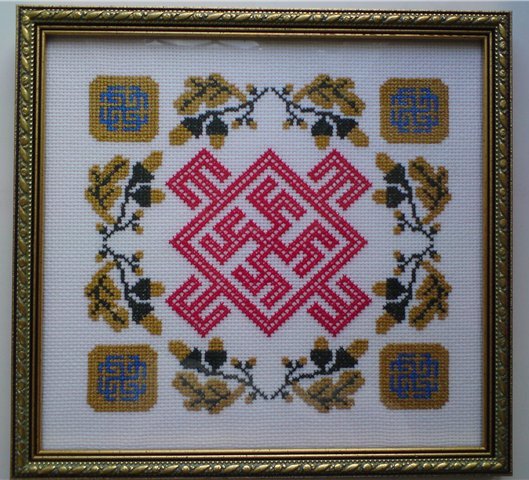 The cornucopia is a sign of abundance and wealth.
The cornucopia is a sign of abundance and wealth.- Yarga, a spinning wheel - a sign of the Sun. The direction of rotation determines the sign of the Sun of Java - the light Sun and the sign of the Sun of Navi - the dark Sun. The Sun of Java is a creative, positive force, the Sun of Nava, on the contrary, destroys and annihilates.
- A tree with raised or lowered branches is a sign of long life, the interconnection of all phenomena of life in nature.
- The spiral is a sign of wisdom. The color scheme is important here: if the spiral is blue or purple, then it is a sign of secret knowledge, if the spiral is red, white or black, then this sign can drive away the strongest shadow entities.
- The triangle is a sign of Man. Usually in its upper part there are small circles or dots. It means friendly communication between people.
Signs of the gods
The figure of a woman with her hands raised to the sky is the goddess Makosh, with her hands lowered down is the goddess Lada. Deer were usually depicted next to them. They correspond to the celestial constellations of Ursa Major and Minor, which were once called elk constellations.
Signs of animals and birds
- Bull - Veles.
- Wolf - Yarilo.
- Raven - Veles, wisdom and death.
- Snake - Veles, Earth, wisdom. Relates to the Lower World.
- Horse - Sun, Solar Gods.
- Swan - Mara, winter, death.
- Bear - Veles.
- Elk or Deer - the goddess of fertility (Rozhanitsa).
- Eagle - Thunder, god Perun.
- Rooster - Fire, Aguna
- Falcon - Fire, Aguna
- Zozulya - life, alive.
- Goat - fertility, fertility.
- Pig - abundance, fertility.
The meaning of the color of the ornament
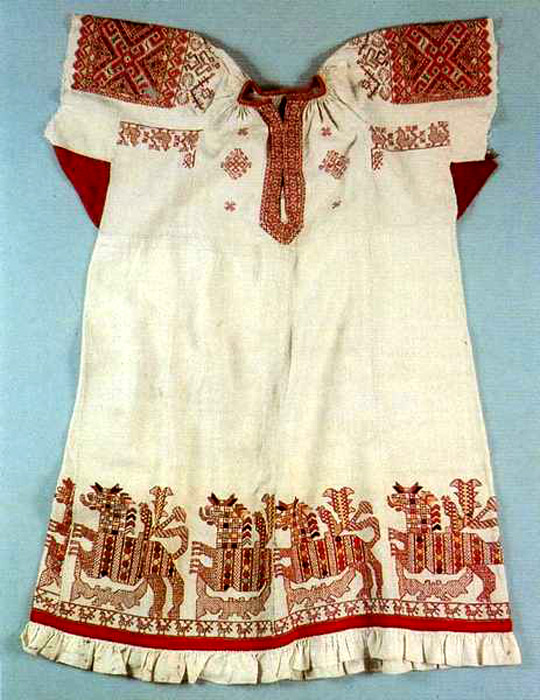 The color of the amulet ornament protects a specific chakra of a person.
The color of the amulet ornament protects a specific chakra of a person.
- Red - protects the lowest chakra, responsible for the musculoskeletal system, rectum, and genitourinary system.
- Orange protects the second chakra - the kidneys and sexual energy.
- Yellow will protect the third chakra - the solar plexus, the center of vital energy.
- Green protects the fourth chakra - the heart. This chakra also includes the lungs, spine, and hands. A person's emotions depend on it.
- Blue protects the fifth chakra, which is responsible for the respiratory organs, hearing, skin, and creative abilities of a person.
- Blue - protection of the sixth chakra, located in the area of the "third eye" and responsible for human intelligence.
- Purple protects the seventh chakra - the crown area that connects a person with God.
- In addition, color can mean the elements of nature that affect our lives.
- White signifies light, purity, and holiness. Sometimes it is the color of mourning and Death.
- Red symbolizes Fire, the Sun (celestial Fire), and blood.
- Green is a symbol of Life and Plants.
- Black symbolizes Earth.
- Gold is a symbol of the Sun.
- Blue means Water and Sky.
Having chosen the ornament, color and composition of the threads, you can start embroidering a talisman for your loved one to protect him from the misfortune that could happen to him. Made according to the rules, an effective talisman will be kept in your family for many years.

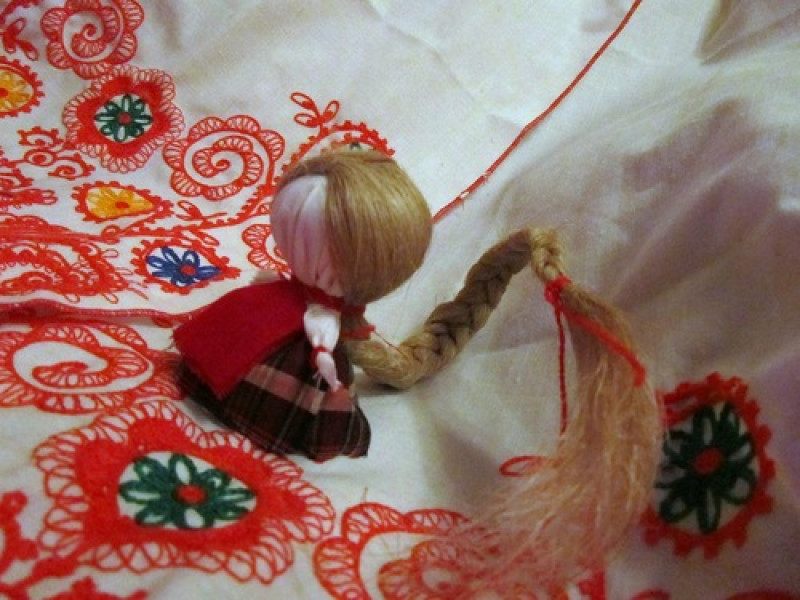
Write a comment